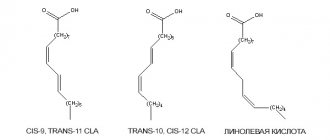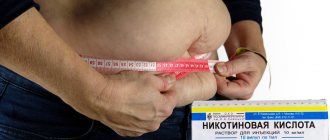pharmachologic effect
Turboslim Alpha-lipoic acid and L-carnitine is an active supplement that promotes more active weight loss by stimulating metabolic processes in the body, as well as the conversion of carbohydrates and fats into energy. This effect is achieved through the combination of those substances that are part of the product.
L-carnitine is a vitamin-like substance, which is similar in characteristics to vitamins, similar in characteristics to B vitamins. Carnitine is synthesized in the body; this substance is found in the muscles and liver. The pharmacological effect of levocarnitine is to activate metabolic processes and stimulate fat metabolism.
L-carnitine should be taken in short courses, since with prolonged treatment, the production of the body’s own L-carnitine is suspended, and as a result, it becomes necessary to artificially compensate for the deficiency of this substance.
Alpha lipoic acid belongs to the group of vitamins. This is a powerful antioxidant that is involved in the oxidation of pyruvic acid. Lipoic acid also reduces blood glucose levels and promotes an increase in glycogen levels in the liver; under its influence, cholesterol metabolism is activated. This substance stimulates cholesterol and participates in the processes of regulation of lipid and carbohydrate metabolism.
Vitamin B1 ensures the normalization of fat and carbohydrate metabolism and has a positive effect on the functions of the digestive, cardiovascular, and nervous systems. It does not accumulate in the body, so a deficiency of this vitamin leads to muscle weakness, irritability, constipation, and numbness of the limbs.
Vitamin B2 provides support for the functions of the thyroid gland, the production of red blood cells , antibodies. Also, under its influence, reproductive function improves, the general condition of hair, skin, and nails improves.
Vitamin B5 is a very important link in oxidation processes. This vitamin is also involved in the metabolism of fats, proteins, and carbohydrates. It is necessary to ensure normal amino acid metabolism, for the synthesis of hemoglobin , fatty acids, histamine, and acetylcholine.
Vitamin B6 in the human body is synthesized by intestinal microflora. It stimulates the body's absorption of glucose and takes part in fat and protein metabolism. This vitamin is essential for normal liver function.
A modern view on the possibilities of using alpha-lipoic acid
Alpha lipoic acid (ALA) is a powerful antioxidant, which makes it possible to use it for the treatment and prevention of a wide range of diseases. The ability of ALA to influence inflammation, apoptosis, blood flow, endothelial dysfunction, activation of neurotransmitters, and metabolic processes determines its widespread use in various fields of medicine.
One of the promising areas for the use of alpha-lipoic acid is neurogenic erectile dysfunction against the background of obesity and metabolic syndrome. Several alpha-lipoic acid preparations are used in Russia, but the greatest practical experience has been accumulated with the drug Espa-lipon, which was one of the first to appear on the Russian market and has proven itself in terms of effectiveness.
Table 1. Differentiated approach to the treatment of metabolic disorders with lipid accumulation in hepatocytes
Clinical pharmacokinetics
Alpha lipoic acid is a disulfide derivative of octanoic acid [1]. ALA is a natural coenzyme of the mitochondria of a multienzyme complex that catalyzes the oxidative decarboxylation of alpha-keto acids such as pyruvate and alpha-ketoglutarate. ALA is a powerful antioxidant, which determines the possibility of its therapeutic use. The structural formula and properties of ALA were discovered in 1951, its first clinical trials were conducted in the same year, and the use of alpha-lipoic acid in humans began in 1970. Early research on the use of ALA was carried out against the backdrop of insufficient understanding of the mechanisms of its action and concerned mainly with lipid and carbohydrate metabolism.
Alpha lipoic acid is both fat- and water-soluble, so it can penetrate into any tissue of the body, providing an antioxidant effect not only outside, but also inside the cell. It also activates the activity of other antioxidants - vitamins A, C, glutathione and coenzyme Q10. ALA has unique properties that make it possible to use it for the treatment and prevention of a wide range of diseases, primarily of the peripheral nervous system and brain, since nervous tissue is extremely sensitive to the toxic effects of free radicals. Traditionally, ALA is used in the treatment of diabetic polyneuropathy. However, the toxic effect of free radicals, including the development of neuropathy and one of its early manifestations - neurogenic erectile dysfunction, is observed in a number of other conditions, such as diabetes mellitus (DM), obesity, aging, long-term use of medications (toxic neuropathy ), metabolic syndrome, metabolic liver diseases.
Pathogenetic use of alpha lipoic acid
The effect of ALA has been well studied in healthy volunteers and diabetic patients. The pharmacokinetic characteristics of ALA when administered intravenously do not differ in healthy people and patients with diabetes; a linear relationship was found between the concentration of ALA in plasma and the dose of the drug administered intravenously in the range from 200 to 1200 mg [2]. When taking tablets in healthy people, the linear dependence of the concentration of ALA in plasma on the dose of the drug was within the range of 50–600 mg. With any method of administration, after 24 hours there is no ALA left in the plasma, since it enters the liver, heart, and kidneys, where it accumulates, followed by excretion [1].
A study of the bioavailability of ALA in healthy subjects when taking tablets on an empty stomach or immediately after breakfast showed that food significantly reduced plasma ALA concentrations. In this regard, it is recommended to take ALA tablets immediately after sleep, 30–45 minutes before meals. ALA undergoes beta-oxidative degradation and is excreted in the urine as metabolites [2]. Numerous experimental studies have demonstrated that ALA is a powerful antioxidant due to its participation in the resynthesis of vitamin E and the ability of ALA to bind free radicals. It has also been suggested that ALA is an antioxidant that protects the sulfhydryl groups of the glucose transporter system, which in turn leads to increased insulin-dependent glucose utilization [1].
Oxidative stress and edema due to plasma extravasation, which develop after traumatic injury to brain tissue, are known to play an important role in the secondary mechanisms of brain dysfunction. The literature considers the possibility of using antioxidant therapy, including ALA, in these cases. In an experiment after traumatic brain injury, ALA reduced the severity of oxidative stress, swelling of brain tissue, and histopathological changes [3]. A number of antioxidants, including ALA, reduce the activation of apoptosis caused by ethanol. A clinical open study of 56 patients with alcoholic polyneuropathy revealed a decrease in positive and negative neuropathic symptoms when taking ALA at a dose of 300 mg daily, and ALA was more effective than thiamine.
In Russia there are several preparations of alpha-lipoic acid, but the greatest practical experience has been accumulated with the drug Espa-lipon, which was one of the first to appear on the Russian market (1995) and has proven itself to be a highly effective remedy. Thanks to optimal dosages, the availability of oral and infusion forms of release, German quality and affordable price, Espa-lipon can be used as widely as possible in modern medicine.
Clinical Applications of Alpha Lipoic Acid
ALA can be used in many diseases, including pathologies of the central nervous system associated with oxidative stress and inflammatory changes. ALA inhibits the migration of T cells into the structures of the central nervous system. It has been shown that ALA can suppress the activity of cells that determine the immune response by inhibiting interleukins in them and stimulating cAMP. Fibroblasts from patients with Alzheimer's disease revealed pronounced oxidative stress associated with mitochondrial dysfunction. In the treatment of Alzheimer's disease, ALA is considered as one of the methods of neuroprotection. The neuroprotective capabilities of ALA are realized by improving mitochondrial function. It has been shown that ALA increases the production of acetylcholine in the brain by activating choline acetyltransferase and increasing the production of acetyl-coenzyme A, reduces cerebral oxidative stress and the synthesis of inducible nitric oxide synthase, which is the basis of its neuroprotective effect and makes it possible to use it in neurodegenerative processes. In two open-label clinical trials, 600 mg ALA was given to patients with Alzheimer's disease for 12 to 48 months and noted a slowing of disease progression in mild dementia (ADAScog
- reduce the level of lipid peroxidation;
- bind and inactivate toxic substrates in the hepatocyte as a result of increasing the synthesis of detoxifying substances;
- block the activity of mesenchymal-inflammatory reactions;
- slow down the progression of fibrosis [5].
Great importance is attached to basic therapy, including:
- cessation of the action of etiological factors;
- complete exclusion of alcohol;
- a diet rich in proteins (1 g of protein per 1 kg of body weight) and water-soluble vitamins, but low in fats;
- normalization of blood glucose, lipids, and uric acid levels in the presence of corresponding disorders.
As a rule, in case of fatty hepatosis with a known etiology, the absence of complications and normal biochemical test results, basic therapy turns out to be sufficient and adequate, and regression of fatty degeneration is observed after 3–6 months. In some cases, with the alcoholic etiology of the process, parenteral administration of water-soluble vitamins (B1, B6, B2, PP, B12, C) in standard therapeutic doses for 10–14 days is required in addition to basic therapy [6]. The main indications for drug therapy are: the development of steatohepatitis and fatty hepatosis of unknown etiology or the inability to stop the action of etiological and additional risk factors for its development [3, 7]. The choice of a specific drug or their combinations in the treatment of metabolic liver damage is influenced by many factors: the etiology and leading pathogenetic links of the process, the degree of activity, the presence of systemic and concomitant diseases, the cost of drugs and, importantly, the knowledge and experience of the doctor (Table 1). The widespread use of alpha-lipoic acid preparations (for example, Espa-lipon) for liver diseases causes the following effects of ALA [1, 5]:
- the ability to reduce the level of lipid peroxidation (binds free radicals and free tissue iron);
- participation in the oxidation of fatty acids and acetate (prevents the development of fatty liver steatosis);
- decarboxylation of beta-keto acids (energy supply to the cell and prevention of the development of ketoacidosis);
- increased transmembrane transport of glucose into the cell (accumulation of glycogen in the cell, increase in its energy balance);
- suppression of nitric oxide synthesis by hepatocytes (prevention and relief of rheological disorders and vascular disorders).
Alpha-lipoic acid preparations are recommended for use in alcoholic and non-alcoholic steatohepatitis, and in fatty steatosis to prevent progression and development of complications. Treatment can be carried out as monotherapy and in combination with other antioxidants and hepatoprotectors.
Currently, there are isolated publications on the effectiveness of treatment of patients with liver diseases associated with the hepatitis C virus, a combination of Espa-lipon 300 mg 2 times a day, silymarin 300 mg 3 times a day and selenomethionine 200 mcg 2 times a day, taken for year [8]. Additionally, a complex of vitamins B, C, E and microelements were prescribed. By the end of the one-year course of treatment, all patients achieved an improvement in clinical and biochemical parameters without eliminating the hepatitis C virus. This study showed that if it is impossible to carry out adequate antiviral therapy (the presence of side effects and contraindications, the ineffectiveness of previous therapy), the use of hepatoprotectors significantly improves the quality of life patient data. Thus, given the wide range of actions to restore almost all types of metabolism in the hepatocyte, alpha-lipoic acid preparations (for example, Espa-lipon) should find widespread use in the treatment of metabolic liver diseases of alcoholic and non-alcoholic origin.
One of the promising areas for the use of alpha-lipoic acid, which we widely use in our work, is neurogenic erectile dysfunction (ED) against the background of obesity and metabolic syndrome. Diagnosis of neurogenic ED, which can be considered a clear clinical manifestation of the negative effect of oxidative stress, leading to a decrease in the secretion of nitric oxide (the main neurotransmitter) by cavernous nerves, is quite simple (Kalinchenko-Rozhivanov method). Determination of penile neuropathy is carried out using the Tiotherm device, which has two different ends - metal (cold) and plastic (warm). Patients with neuropathy cannot distinguish the difference between a cold end and a warm end.
According to epidemiological studies, the incidence of diabetic neuropathy (DN) in diabetes varies from 5 to 100% depending on the examination methods used. Differences in incidence are due to the use of different criteria for diagnosing DN [9]. According to the prevailing point of view, the earliest and most common form of DN is diabetic peripheral polyneuropathy (DPN). 7.5% of patients with newly diagnosed type 2 diabetes already have clinical and laboratory manifestations of DPN [9]. However, according to our numerous studies, the earliest and most common form of DN in men with diabetes is erectile dysfunction, which significantly worsens the quality of life not only of the man, but also of the married couple, and is also the cause of the development of depression, which negatively affects the ability to achieve carbohydrate compensation. exchange.
We studied the clinical and epidemiological characteristics of neurogenic forms of sexual dysfunction in men with diabetes [10]. A continuous one-time study included 611 patients with diabetes (representative sample) living in various regions of the Russian Federation. All patients were surveyed using the International Index of Erectile Function 5 (IIEF-5) questionnaire and Aging Male Symptoms according to Heinemann. The degree of compensation of carbohydrate metabolism was assessed by the level of glycated hemoglobin (HbA1c) (the norm is up to 6.4%). Screening for diabetic polyneuropathy was carried out by studying vibration, temperature and tactile sensitivity of the lower extremities (NDS scale according to Young and TSS scale). To identify neuropathy of the genital organs, vibration, tactile and temperature sensitivity of the penis was assessed using the Kalinchenko-Rozhivanov method. To study the hemodynamics of the penis, Doppler ultrasound was performed using a Minimax Doppler Fono device from Minimax with a 10 MHz sensor. Statistica software package (StatSoft Inc., USA, version 6.0) was used for statistical data processing.
An increase in the prevalence of ED in older age groups has been revealed. With age, both men and women experience a decrease in the secretion of sex hormones - important endogenous antioxidants, which aggravates the manifestations of oxidative stress, and in a number of patients without diabetes is the leading cause of its occurrence. In addition, we found that the neurogenic form of ED in patients with type 1 and type 2 diabetes occurred before the first clinical manifestations of distal diabetic neuropathy in no less than 37.4 and 51.9% of cases, respectively. This feature makes it possible to use the neurogenic form of ED as an early clinical prognostic sign of the development of distal diabetic neuropathy. It should be noted once again that diabetes mellitus is not the only cause of the development of neurogenic erectile dysfunction. When determining the sensitivity of the penis became routine practice, we began to identify a sufficient prevalence of ED in men without diabetes. We were able to identify several reasons for the development of neurogenic ED, on the basis of which we propose the following classification of neurogenic ED:
- Diabetic neurogenic ED.
- Traumatic neurogenic ED (often observed after operations on the pelvic organs and penis).
- Toxic neurogenic ED (develops against the background of alcohol intake, long-term use of medications, uremia, liver damage, vitamin deficiency; neuropathy developed against the background of infections, systemic diseases, allergic diseases).
- Age-related neurogenic ED (develops against the background of decreased testosterone secretion).
Timely use of ALA for neurogenic erectile dysfunction in the setting of obesity is a prevention of the development of vascular erectile dysfunction, which is quite difficult to treat and precedes more serious vascular disasters such as stroke and coronary heart disease. Oxidative stress, hypercholesterolemia, endothelial activation and monocyte adhesion are the links in the formation of atherosclerotic lesions of the vascular wall.
The experiment proved that the administration of ALA reduced the size of atherosclerotic plaques in the abdominal aorta, which was accompanied by a decrease in the content of fatty and inflammatory cells in the aortic wall. ALA improved the vascular response to angiotensin II, acetylcholine and insulin, and reduced oxidative stress. The use of ALA reduces free radical damage to myocytes due to oxidative stress during myocardial ischemia. In the experiment, the administration of ALA led to a significant decrease in apoptosis, a decrease in lipid peroxidation, and an increase in the activity of glutathione in the mitochondria of cardiomyocytes, which prevented the development of irreversible disorders of cardiac function. In the ISLAND study, taking ALA tablets at a dose of 300 mg as monotherapy in patients with metabolic syndrome for 4 weeks led to an increase in endothelium-dependent vasodilation of the brachial artery, which was accompanied by a decrease in plasma interleukin-6 and plasminogen activator-1. Thus, the effect of ALA on endothelial dysfunction, realized through its effect on anti-inflammatory and antithrombotic mechanisms, has been shown [11].
Pilot studies have shown that ALA reduces apoptosis associated with oxidative stress but stimulates apoptosis in various cancer cells. An experiment on cell culture showed that ALA dose-dependently inhibits the proliferation of human breast cancer cells and activates the process of apoptosis in them. Similar results were obtained for lung cancer cells, with ALA activating apoptosis in cancer cells through both caspase-independent and caspase-dependent pathways. Doctors from New Mexico (USA) described the case of a patient with pancreatic cancer with liver metastases, whose condition improved after ALA infusions in combination with low-dose naltrexone. The patient was alive and well 78 months after initial presentation. Cisplatin, a widely used anticancer drug, increases lipid peroxidation and decreases the activity of antioxidant enzymes in renal tissue. Treatment with cisplatin can cause acute kidney damage, and irreversible filtration impairment may occur. The experiment showed that ALA reduces the symptoms of acute kidney injury by reducing the expression of inflammatory adhesion molecules and apoptosis processes. Chemotherapy with cisplatin and paclitaxel can cause damage to peripheral nerves due to dysfunction of the mitochondrial apparatus of cells. The experiment showed that ALA can prevent the development of polyneuropathy by reducing oxidative stress and protecting mitochondria from damage when using these drugs [12].
Conclusion
Thus, an analysis of experimental and clinical studies indicates the universality of the antioxidant effect of ALA in the vascular bed and cytoplasm of the cellular structures of various organs. The ability to use alpha-lipoic acid to influence inflammation, apoptosis, blood flow, endothelial dysfunction, activation of neurotransmitters, and metabolic processes allows us to consider its preparations as a potential drug in various fields of medicine. We believe that in all patients with neurogenic erectile dysfunction, the use of alpha-lipoic acid should be a course regimen, and discontinuation of the drug is possible only after complete restoration of sexual function and elimination of the causes of oxidative stress (elimination of obesity, metabolic syndrome, toxic factors).
special instructions
Before starting to take the drug, you must consult a specialist.
This remedy should be taken with caution by people suffering from thyroid , as well as patients with diabetes , since lipoic acid reduces blood glucose levels. In this case, you may need to adjust the dose of medications to reduce sugar.
Since L-Carnitine stimulates the secretion of gastric juice, people suffering from ulcers or gastritis, in which there is increased secretion of gastric juice, should take dietary supplements with caution.
Reviews from doctors
This remedy, according to doctors, is highly effective in eliminating extra pounds. Helps normalize metabolism, removes waste and toxins. The drug contains B vitamins, which nourish the body and make it more resilient. A person’s well-being improves significantly. Doctors also note the ability of the product to burn fat deposits, but this occurs only when playing sports . The process is activated during training and allows you to quickly and effectively get rid of excess weight.
Doctors recommend following the instructions and not exceeding the dosage, otherwise you may experience side effects. It is strongly recommended that you carefully read the contraindications. Only by following these rules will a person be able to lose extra pounds, normalize metabolism, and become healthier.
Reviews of Turboslim Alpha-lipoic acid and L-carnitine
There are conflicting reviews about Turboslim Alfa. Many people leave reviews about Turboslim Alfa, which indicate its effectiveness. In particular, those who play sports claim that the pills not only stimulate weight loss, but also significantly increase endurance.
Feedback from nutritionists about Turboslim Alfa is less common. But doctors still note that before taking these pills, you need to take into account all contraindications and be sure to consult a specialist.
There are reviews from those losing weight that lipoic acid and carnitine only provide temporary results, and after the course of treatment is completed, the metabolism becomes the same. It is also noted that side effects rarely occur when taking the drug.
Analogs
If you cannot find this product in a pharmacy, it is recommended to pay attention to analogues that have a similar effect and a high degree of effectiveness. The most well-known analogues include:
- Garcinia-Forte.
- A-Slim.
- Phytodiet.
- Cytrimax.
- Slim Veda.
These remedies are used twice a day. The exact dosage and duration of taking the drugs are determined by the doctor. Contraindications and side effects are possible, so consultation with a doctor is necessary.
Price Turboslim Alpha-lipoic acid and L-carnitine, where to buy
On average, the price of Turboslim Alpha is from 280 rubles per pack of 20 pcs. Packaging cost 60 pcs. – from 600 to 700 rubles. You can find out more about how much the drug costs at the places where it is sold.
- Online pharmacies in RussiaRussia
- Online pharmacies in KazakhstanKazakhstan
ZdravCity
- Turboslim tablets Alphalipoic acid and L-carnitine 0.55g 60 pcs. Evalar JSC
769 rub. order - Turboslim tablets Alphalipoic acid and L-carnitine 0.55g 20 pcs. Evalar JSC
RUB 317 order
Pharmacy Dialogue
- Turboslim Alpha-lipoic acid and L-carnitine tablets No. 20Evalar JSC
RUB 354 order
- Turboslim Alpha-lipoic acid and L-carnitine tablets 0.55g No. 60Evalar JSC
RUB 896 order
show more
Price
The price of Turboslim Alpha depends on the form of release and places of sale. On the official website of the Evalar company, the cost of a package of 20 tablets is 289 rubles, of 60 - 656 rubles. A pack of 6 bottles of the fat-burning drink will cost 434 rubles.
You can also buy products in online pharmacies in Russia. In this case, for a package of 20 or 60 tablets you will have to pay 300 and 700 rubles, respectively. The fat-burning drink can be purchased at prices ranging from 560 to 820 rubles for 6 bottles.
Since dietary supplements from the Evalar company have become widespread and are popular among people who are losing weight and leading an active lifestyle, they are sold by pharmacy chains. The price should be confirmed on site.









